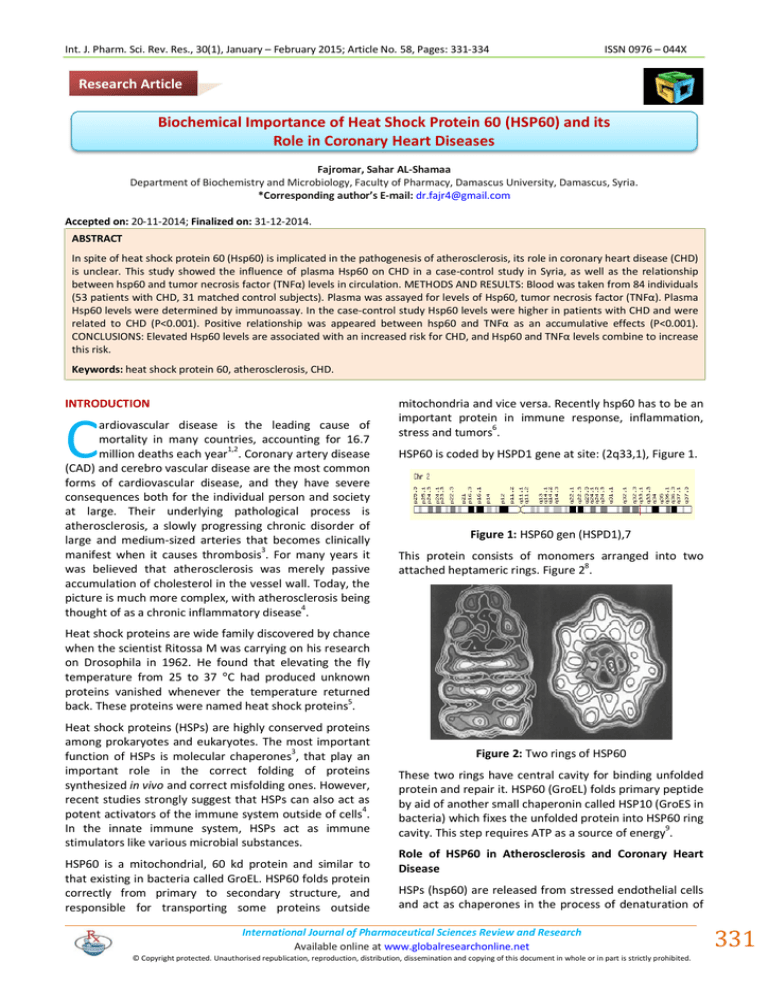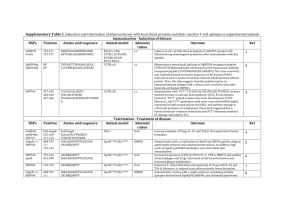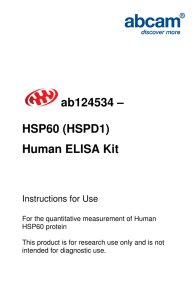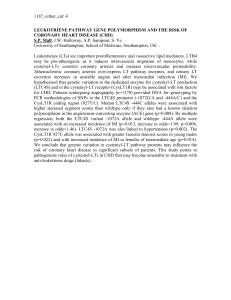Document 13310233
advertisement

Int. J. Pharm. Sci. Rev. Res., 30(1), January – February 2015; Article No. 58, Pages: 331-334 ISSN 0976 – 044X Research Article Biochemical Importance of Heat Shock Protein 60 (HSP60) and its Role in Coronary Heart Diseases Fajromar, Sahar AL-Shamaa Department of Biochemistry and Microbiology, Faculty of Pharmacy, Damascus University, Damascus, Syria. *Corresponding author’s E-mail: dr.fajr4@gmail.com Accepted on: 20-11-2014; Finalized on: 31-12-2014. ABSTRACT In spite of heat shock protein 60 (Hsp60) is implicated in the pathogenesis of atherosclerosis, its role in coronary heart disease (CHD) is unclear. This study showed the influence of plasma Hsp60 on CHD in a case-control study in Syria, as well as the relationship between hsp60 and tumor necrosis factor (TNFα) levels in circulation. METHODS AND RESULTS: Blood was taken from 84 individuals (53 patients with CHD, 31 matched control subjects). Plasma was assayed for levels of Hsp60, tumor necrosis factor (TNFα). Plasma Hsp60 levels were determined by immunoassay. In the case-control study Hsp60 levels were higher in patients with CHD and were related to CHD (P<0.001). Positive relationship was appeared between hsp60 and TNFα as an accumulative effects (P<0.001). CONCLUSIONS: Elevated Hsp60 levels are associated with an increased risk for CHD, and Hsp60 and TNFα levels combine to increase this risk. Keywords: heat shock protein 60, atherosclerosis, CHD. INTRODUCTION C ardiovascular disease is the leading cause of mortality in many countries, accounting for 16.7 million deaths each year1,2. Coronary artery disease (CAD) and cerebro vascular disease are the most common forms of cardiovascular disease, and they have severe consequences both for the individual person and society at large. Their underlying pathological process is atherosclerosis, a slowly progressing chronic disorder of large and medium-sized arteries that becomes clinically manifest when it causes thrombosis3. For many years it was believed that atherosclerosis was merely passive accumulation of cholesterol in the vessel wall. Today, the picture is much more complex, with atherosclerosis being thought of as a chronic inflammatory disease4. mitochondria and vice versa. Recently hsp60 has to be an important protein in immune response, inflammation, stress and tumors6. HSP60 is coded by HSPD1 gene at site: (2q33,1), Figure 1. Figure 1: HSP60 gen (HSPD1),7 This protein consists of monomers arranged into two attached heptameric rings. Figure 28. Heat shock proteins are wide family discovered by chance when the scientist Ritossa M was carrying on his research on Drosophila in 1962. He found that elevating the fly temperature from 25 to 37 °C had produced unknown proteins vanished whenever the temperature returned back. These proteins were named heat shock proteins5. Heat shock proteins (HSPs) are highly conserved proteins among prokaryotes and eukaryotes. The most important function of HSPs is molecular chaperones3, that play an important role in the correct folding of proteins synthesized in vivo and correct misfolding ones. However, recent studies strongly suggest that HSPs can also act as 4 potent activators of the immune system outside of cells . In the innate immune system, HSPs act as immune stimulators like various microbial substances. HSP60 is a mitochondrial, 60 kd protein and similar to that existing in bacteria called GroEL. HSP60 folds protein correctly from primary to secondary structure, and responsible for transporting some proteins outside Figure 2: Two rings of HSP60 These two rings have central cavity for binding unfolded protein and repair it. HSP60 (GroEL) folds primary peptide by aid of another small chaperonin called HSP10 (GroES in bacteria) which fixes the unfolded protein into HSP60 ring cavity. This step requires ATP as a source of energy9. Role of HSP60 in Atherosclerosis and Coronary Heart Disease HSPs (hsp60) are released from stressed endothelial cells and act as chaperones in the process of denaturation of International Journal of Pharmaceutical Sciences Review and Research Available online at www.globalresearchonline.net © Copyright protected. Unauthorised republication, reproduction, distribution, dissemination and copying of this document in whole or in part is strictly prohibited. 331 © Copyright pro Int. J. Pharm. Sci. Rev. Res., 30(1), January – February 2015; Article No. 58, Pages: 331-334 other proteins. They can induce the production of specific antibodies which usually accelerate atherosclerotic plaque development when used to immunise 10 experimental animals . Human and microbial HSP60 activate vascular endothelial cells and macrophages directly through CD14 and p38 mitogen-activated protein kinase signaling pathway in a similar manner as bacterial lipopolysaccharide (LPS)11, leading to IL-6 and TNF-α secretion and promotion of atherosclerosis. HSPs are highly conserved among different species. Antibodies involved in the atherosclerotic development 12 recognise both human and microbial HSPs . Under physiological conditions, vascular endothelial cells (ECs) do not express HSP60. However, when stressed by classical atherosclerosis risk factors, the simultaneous expression of adhesion molecules and HSP60 by ECs leads to a (cross) reaction against and destruction of these target cells by preexisting cellular and humoral immunity against HSP60, entailing intimal infiltration by mononuclear cells13 (Figure 3). ISSN 0976 – 044X macrophages) and by ECs and SMCs expressing MHC class I and class II (induced by interferon-γ). In addition, circulating anti-HSP60 antibodies are present. During progression from an early lesion to a severe plaque, EC damage via anti-HSP60 antibodies, an increased number of macrophages and SMCs often loaded with lipids (foam cells), and neovascularization can be demonstrated14. Many researches referred to the cross immunity reaction through infection with some bacteria such as helicobacter pylori, Chlamydiapneumonia and E.coli. These bacteria contain a protein mimics human HSP60, so by chronic infection with these bacteria will develop antibodies attack human HSP60 itself and destroy the cells that appear the protein on surface such as stressed 15 endothelial cells . MATERIALS AND METHODS We applied our study on 84 Syrian persons. Samples of blood were drawn through 4 months (December 2010 – April 2011). The individuals were divided into two groups as follows: 1. Control group: consists of 31 persons (51 ± 12 old). They were apparently healthy, nor CHD neither diabetes, hypertension, and chronic inflammatory disorders. 2. CHD group: consists of 53 persons (50 ± 11 old), CHD diagnosed with at least 50% obstruction in one or more coronary arteries. All cases of diabetes, hypertension, inflammatory disorders were executed. 10 ml of blood was collected on dry tube, left until complete clotting. The samples were centrifuged 3500 rpm for 10 minutes. Serum was obtained and kept in -80 c until assay date through next 6 months. HSP60 was assayed by ELISA kit (stressgen company – united states), Catalog Number: EKS-600. TNFα was also assayed by ELISA kit (Hycult biotech – Netherland), Catalog Number: HK307. RESULTS Figure 3: Schematic overview of HSP60 expression/function in early and late atherosclerosis. Stress-induced EC surface expression of adhesion molecules and HSP60 enables T cells, monocytes, and dendritic cells to adhere to the ECs and transmigrate into + the intima. The T cells (mostly CD4 ) are the first cells entering the intima during early atherosclerosis. Antigen recognition can be performed both by professional antigen-presenting cells (dendritic cells and Our study revealed important elevation of serum HSP60 levels in CHD patients (mean of levels = 29.7 ± 17.4 ng/ml) compared with control ones (mean of levels = 17.7 ± 9.5 ng/ml), (p = 0.0001), Fig 4:A. On other hand this study showed important elevation of TNFα levels in CHD patient (mean of levels = 72.8 ± 29 pg/ml) compared with control ones (mean of levels = 22 ± 10 pg/ml), (p< 0.0001), Fig 4:B. In addition our study confirmed a positive correlation between HSP60 and TNFα levels (p< 0.001), Fig 4:C. International Journal of Pharmaceutical Sciences Review and Research Available online at www.globalresearchonline.net © Copyright protected. Unauthorised republication, reproduction, distribution, dissemination and copying of this document in whole or in part is strictly prohibited. 332 © Copyright pro Int. J. Pharm. Sci. Rev. Res., 30(1), January – February 2015; Article No. 58, Pages: 331-334 Figure 4A: Mean levels of HSP60 in CHD Group, Control ones. Figure 4B: Mean of TNFα levels in CHD Group and Control ones. ISSN 0976 – 044X Figure 4C: Important Correlation between HSP60, TNFα levels in CHD Populations. DISCUSSION REFERENCES This study has revealed an important elevation in serum HSP60 levels in CHD group compared with control ones. HSP60 plays an important role in pathophysiology of atherosclerosis,the stress of endothelium whatever the causes enhances more production of HSP60 in endothelial cells to protect themselves. 1. Dahlof B, Cardiovascular disease risk factors: epidemiology and risk assessment. Am. J. Cardiol, 105, 2010, 3A–9A. 2. Lloyd-Jones D.M., Cardiovascular risk prediction: basic concepts, current status, and future directions, Circulation, 121, 2010, 1768–1777. 3. Hansson G.K, Inflammation, atherosclerosis, and coronary artery disease, N. Engl. J, Med, 352, 2005, 1685–1695. 4. Boyle J, Macrophage activation in atherosclerosis, Pathogenesis and pharmacology of plaque rupture, 3(1), 2005, 65-66. 5. Mongkolsuk S, Schumann W., Stress goes Far East: meeting report of the Sixth International Workshop on the Molecular Biology of Stress Responses, Cell Stress Chaperones, 14(3), 2009, 227–231. 6. Trivedi V., Gadhvi P., Chorawala M., Shah G. Role of heat shock proteins in immune response and immunotherapy for human cancer, International Journal of Pharmaceutical Sciences Review and Research, 2(2), 2010, 58-60. 7. Faried LS, Faried A. HSPD1 (Heat Shock 60kDa Protein 1) Atlas Genet CytogenetOncolHaematol, 2007. 8. Alexzander A. A., Asea and De Maio A., Heat Shock Proteins: Potent Mediators of Inflammation and Immunity, springer, 2007, 123-126. 9. Hartl F., Arthur L., A mystery unfolds: Franz-Ulrich Hartl and Arthur L, Horwich win the Albert Lasker Basic Medical Research Award, The Journal of Clinical Investigation, 2011, 1-4. Over production will spread the protein HSP60 on the surface of stressed cells and into circulation16. HSP60 is a strong stimulator of immunity, it stimulates endothelial cells by expression endothelin-1. Released HSP60 acts as a chemo attractive of macrophages and lymphocytes to the site and they in turn release many proinflammatory mediators and cytokines. On other hand formed HSP60 auto antibodies attack the cells appear the protein on their surface the matter that damages the endothelium and accelerates the atherosclerosis at site17. Our results agreed with each (Zhang X) study results18, (Shamaei-Tousi A.) results19, and (Xiao) results20. This study showed high levels of TNFα in CHD patients compared with controls, that confirms the inflammation theory in atherosclerosis. Many inflammatory mediators such as TNFα cytokine are released from lymphocytes and activated macrophages21. Positive and strong relationship between HSP60 and TNFα levels was confirmed through our study in CHD group. This connection is due to the joint source altogether which is inflammation. Circulatory HSP60 is a strong immune activator that enhances macrophages and lymphocytes to release a lot of cytokins especially TNFα. This is a synergistic effect that activates atherosclerosis in site and CHD development in turn22. This agreed with (Alberse JA) and (Lewthwaite J.) study results23. CONCLUSION Heat shock protein 60 (HSP60) is elevated in all stages of atherosclerosis and may be an important risk biomarker for Coronary heart disease. 10. L. J. Jara, G. Medina, O. Vera-Lastra, and M. C. Amigo, “Accelerated atherosclerosis, immune response and autoimmune rheumatic diseases,” Autoimmunity Reviews, 5(3), 2006, 195–201. 11. Kol A, H. Lichtman R. W., Finberg P. Libby, and E. A. KurtJones A, “Cutting edge: heat shock protein (HSP) 60 activates the innate immune response: CD14 is an essential receptor for HSP60 activation of mononuclear cells,” Journal of Immunology, 164, 2000, 13–17. 12. D. J. Lamb W, El-Sankary E, and G. A. A. Ferns D, “Molecular mimicry in atherosclerosis: a role for heat shock proteins in immunisation,” Atherosclerosis, 167, 2003, 177–185. 13. Zhang X, Mei'an He, Cheng L, Ying Chen, Li Zhou, HesongZeng A, Pockley G, Frank B, and Tangchun Wu, International Journal of Pharmaceutical Sciences Review and Research Available online at www.globalresearchonline.net © Copyright protected. Unauthorised republication, reproduction, distribution, dissemination and copying of this document in whole or in part is strictly prohibited. 333 © Copyright pro Int. J. Pharm. Sci. Rev. Res., 30(1), January – February 2015; Article No. 58, Pages: 331-334 Elevated Heat Shock Protein 60 Levels are Associated With Higher Risk of Coronary Heart Disease in Chinese, Circulation, 118, 2008, 2687-2693. 14. Grundtman C, Kreutmayer S, Almanzar G, Marius C and Georg W, Heat Shock Protein 60 and Immune Inflammatory Responses in Atherosclerosis, ArteriosclerThrombVascBiol, 31, 2011, 960-968. 15. Fuji N, Yokota Sh, Immunomodulatory activity of extracellular heat shock proteins and their auto antibodies. Journal of Microbiology and Immunology, 54, 2010, 300304. 16. Kim C, Gupta S, Davis B, Torre-Amione G, and Knowlton A, In cardiac myocyte apoptosis HSP60 in heart failure: abnormal distribution and role, Journal of Heart Circ. Physiol, 293, 2007, H2238-H2244. 17. Wick G, Knoflach M, Xu Q, Autoimmune and inflammatory mechanisms in atherosclerosis, Annu Rev Immunol, 22, 2004, 361–403. 18. Shamaei-Tousi A, Steptoe A, O'Donnell K, Palmen J, Stephens JW, Hurel SJ, Marmot M, Homer K, D'Aiuto F, Coates AR, Humphries SE, and Henderson B, Plasma heat shock protein 60 and cardiovascular disease risk: the role ISSN 0976 – 044X of psychosocial, genetic, and biological factors. Cell Stress Chaperones, 12(4), 2007, 384-392. 19. Bachmaier K, J. Penninger J. M, Chlamydia and antigenic Mimicry, Current Topics in Microbiology and Immunology, 296, 2005, 153–163. 20. Manzi S, Meilahn EN, Rairie JE, Conte CG, Medsger TA Jr, and Jansen-McWilliams L, Age-specific incidence rates of myocardial infarction and angina in women with systemic lupus erythematosus: comparison with the Framingham Study, Am J Epidemiol, 145(5), 2008, 408-415. 21. Gayle E, David W, Carey M, Sattar N, and McInnes I, Role for TNF in atherosclerosis? Lessons from autoimmune disease, Nature Reviews Cardiology, 6, 2009, 410-417. 22. Alberse JA, Kapitein B, Roock S, Klein M, de Jager W, van der Zee R, Hoekstra M, Wijk F, and Prakken B, Cord Blood CD4+ T Cells Respond to Self-Heat Shock Protein, 60 (HSP60), PLUS ONE, 6(241), 2011, 1-8. 23. Lewthwaite J, Owen N, Coates A, Henderson B, and Steptoe A, Circulating human heat shock protein 60 in the plasma of British civil servants: relationship to physiological and psychosocial stress, Circulation, 106(2), 2002, 196-201. Source of Support: Nil, Conflict of Interest: None. International Journal of Pharmaceutical Sciences Review and Research Available online at www.globalresearchonline.net © Copyright protected. Unauthorised republication, reproduction, distribution, dissemination and copying of this document in whole or in part is strictly prohibited. 334 © Copyright pro



